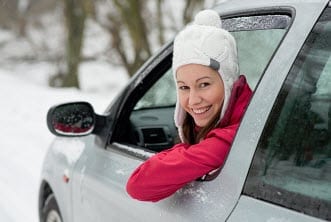It’s that time of the year again, when snow storms can blanket roadways in inches of white powder.
For motorists, there are several important tips to stay safe during these times when roads are snow covered. In most situations when snow is falling, the absolute best course of action is to remain off the roads. However, this is obviously not possible all the time so these tips below should serve as some guideposts to help drivers stay as safe as possible during treacherous weather.
Tires
Having the right tires on your vehicle is one of the most important aspects of winter driving. If you use tires built for the spring/summer, make sure you have winter tires placed on your car before the first snow begins to fall. All-weather tires and snow tires are produced for most vehicles and offer designs specifically meant to gain traction and maintain control during hazardous weather. Make sure these tires are properly inflated also.
Speed
It’s important to accelerate and decelerate slowly during snowy conditions. Apply the gas pedal slowly – do not “gun it” on the gas pedal. Using too much gas on snow covered roads simply makes your tires spin without traction. In addition to starting off more slowly, remember to maintain a slower driving speed along the way.
Braking
Do not “slam” on the brakes. In addition to using less speed, it’s important to remember that the stopping distances for most vehicles increases significantly on snow covered roads. It’s possible for wheels to lock up if the brakes are applied too quickly in snowy conditions, which could cause your vehicle to slide out of control. Driving slow allows for easier application of your brakes.
Steering
When steering, look and steer in the direction you want to go. Counter-steering or over-steering could cause you to lose control of your vehicle.
Visibility
Always keep your lights on when driving in the snow to make yourself as visible as possible. Make sure all of your lights are working to ensure other motorists can see you. Use your turn signals as well. In certain areas, if you’re traveling below a certain speed threshold, make sure that your flashers are on to alert other motorists of your position. It is not recommended to use high-beam lights in falling snow, even if the visibility is bad. High beam lights, or “brights” can reflect off of falling snow, further reducing your visibility. If you are preparing to drive your car in a storm, be sure that your signal lights are free of snow, and could be visible to cars traveling around you.
Fuel
Always keep your gas tank at least half full. This ensures you won’t get stranded due to running out of gas, and it also keeps the gas line from freezing up. Often, the delays caused by wintery conditions can be much longer than you expect. If you were to be stuck in slow moving, or halted traffic in winter weather, a full gas tank could keep you warm, and keep your vehicle running till you reached your destination.
These simple tips can be the difference between life and death on the road. It’s important for you to know your vehicle, be aware of your surroundings, and always wear your seat belt every time you’re out on the road to be as safe and secure as possible.
About Marlena Stoddard
Marlena Stoddard writes on small business and entrepreneurship. Originally from Senoia, GA, Marlena lives in Santa Rosa, CA with her husband and 2 children. If the bad weather does cause you to get in an accident, Marlena always recommends seeking out the advice of a good automotive or motorcycle accident lawyer.
